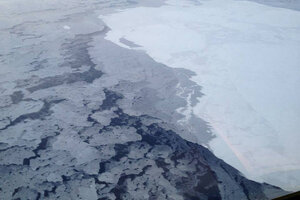Is Arctic sea ice more resilient than scientists thought? Yes and no.
Arctic sea ice volume increased a surprising amount during the cool summer of 2013, but researchers say if overall temperatures continue rising, ice will melt in the long run.

This handout photo provided by The National Oceanic and Atmospheric Administration (NOAA) shows Arctic sea ice in 2013. Research published Monday in Nature Geoscience showed sea ice volume increased significantly due to cool temperatures during the summer of 2013, but warned that future warm summers would probably lead to more melting.
National Oceanic and Atmospheric Administration/AP/File
Recent research on Arctic sea ice revealed surprising news: despite downward trends in sea ice extent since the 1970s, total sea ice volume grew by 41 percent in 2013, suggesting it may be more “resilient” than believed.
The researchers said less ice melted near Greenland during 2013’s unusually cool summer, during which temperatures were comparable to those of the late 1990s, and gains lasted through the fall of 2014, when sea ice volume fell slightly but remained above the five-year average.
“We now know it can recover by a significant amount if the melting season is cut short,” the study’s lead author Rachel Tilling, a researcher who studies satellite observations of the Arctic told The Wall Street Journal. “The sea ice might be a little more resilient than we thought.”
However, Ms. Tilling and her fellow researchers warned in the paper, published Monday in the journal Nature Geoscience, that if Arctic temperatures continue to rise as expected, variability as seen in 2013 will not prevent sea ice from diminishing overall. Mark Serreze, director of the National Snow and Ice Data Center, also told The Washington Post the data does not mean sea ice is suddenly safe.
“These people are not making any claim that we’re going to have some big recovery [in sea ice],” Dr. Serreze said. “But it’s going to occur in fits and starts because the sea ice is highly variable – we’re going to go up some years, down in others.”
This study focused specifically on five years of data, Tilling qualified. In terms of drawing long-term conclusions about the direction in which sea ice will lean, she told the Post, “it’s very difficult to say one way or the other.”
“We do not want to suggest that this is a recovery in the long term,” Tilling said. “If you look at the long-term temperature trend in the Arctic, it’s upward, and if you look at the long-term volume trend, it’s downward. If temperatures continue to rise, volume is going to continue to decrease.”
Though conclusions from the study about sea ice resilience may be limited, Tilling wrote in the paper that the study went beyond previous research by measuring the volume of ice, not just the surface area. “Despite a well-documented decline in summer Arctic sea ice extent by about 40% since the late 1970s, it has been difficult to quantify trends in sea ice volume because detailed thickness observations have been lacking,” she wrote.
“Sea ice is complex – it doesn’t just grow in area, it grows in thickness,” Tilling told the Post. “To see what’s really happening, you need to look beneath the surface.”

